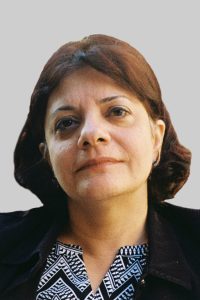By Kaitlin Bender-Thomas
Medill Professor Kalyani Chadha’s new book, “Disrupting Mainstream Journalism in India,” explores how India’s mainstream media has historically excluded or misrepresented marginalized communities and how alternative journalism is pushing back against it. In this Q&A, Chadha reflects on how her scholarship has shaped her teaching and why it matters for the next generation of journalists.
 Q. How has your research informed your teaching, and have you brought any of these themes into the classroom at Medill?
Q. How has your research informed your teaching, and have you brought any of these themes into the classroom at Medill?
A. I have in a graduate classroom, not so much in an undergraduate classroom, mainly because of what I teach. But what I have tried to do is sensitize students to the coverage of marginalized communities, broadly speaking, in the United States. So that’s very much a part of the version of JOUR 202 that I developed. You know, how do we cover marginalized communities more sensitively?
In my graduate classes, of course, I’ve tried to talk a lot about the theoretical ideas of the book, which is how digital affordances allow different kinds of marginalized groups to create what are called counterpublics or counterpublic spheres — so, arenas in which they operate. And I just taught a PhD-level class where we had extensive discussion of these ideas.
Q. Why do you think it’s so important to teach students how to cover marginalized communities with sensitivity and care?
A. Here’s the thing. I think the best journalism is journalism that sort of looks at things from other people’s points of view. It’s easy to empathize with people like yourself. But as it turns out, a lot of people are not like oneself, whether it’s in a demographic sense or whether it’s in the sense of some kind of other issue.
So I feel like good journalism is empathetic journalism at some level, or at least journalism that provides — even if you can’t empathize — maybe journalism that enables you to develop perspective. It gives your audience some perspective on other people’s lives, other positions, other ways of looking at the world, or other ways of being. I think studying groups that have been marginalized really hopefully does that for students because, as I said, it’s very easy to do journalism and to feel empathetic when you focus on people like yourselves. It’s just infinitely harder when it’s people who are different from you, in whatever capacity.
Q. What advice would you give to journalists who are trying to cover communities that are different from their own and still produce good journalism?
A. Ask yourself, at some level at least, what are my own biases? How do I look at these things? People will say, ‘I don’t have biases.’ I would beg to differ. We all have these notions of how we think about people who are different from us. Try to go into a community and try to find people who have an understanding of the community. Don’t just rely on official sources. Don’t just rely
on what you think is happening. Try to get a sense from someone who’s a part of the community
— what is going on there? Be open about what you don’t know. Being a know-it-all does not help. Like, “I know how I’m gonna write this story.” Well, why bother to go to the neighborhood then?
And yes, it’s very difficult when you’re not a part of the community. Most marginalized communities have zero reason to trust the mainstream press. Their experiences in general do not lead them to do so, and you have to understand that.
Q. What do you hope students and journalists take away from your book?
A. I think they should question the nature of their practice. It’s very easy to write a story that runs according to some pre-existing template in your head or within your organization. It’s very easy to tell a story by calling the same sets of sources or taking whatever the official line is, or whatever some institutional person or official gives you.
I hope people will learn that stories are complex, with many perspectives that often go unexplored. They should be trying to look for those stories, look for those voices that don’t get represented. Be challenging. Is what seems to be the story really the story? What else could be going on there? Whose voice is being heard? What voices aren’t being heard? What kinds of stories are being covered? Who’s just not in the news for whatever reason?